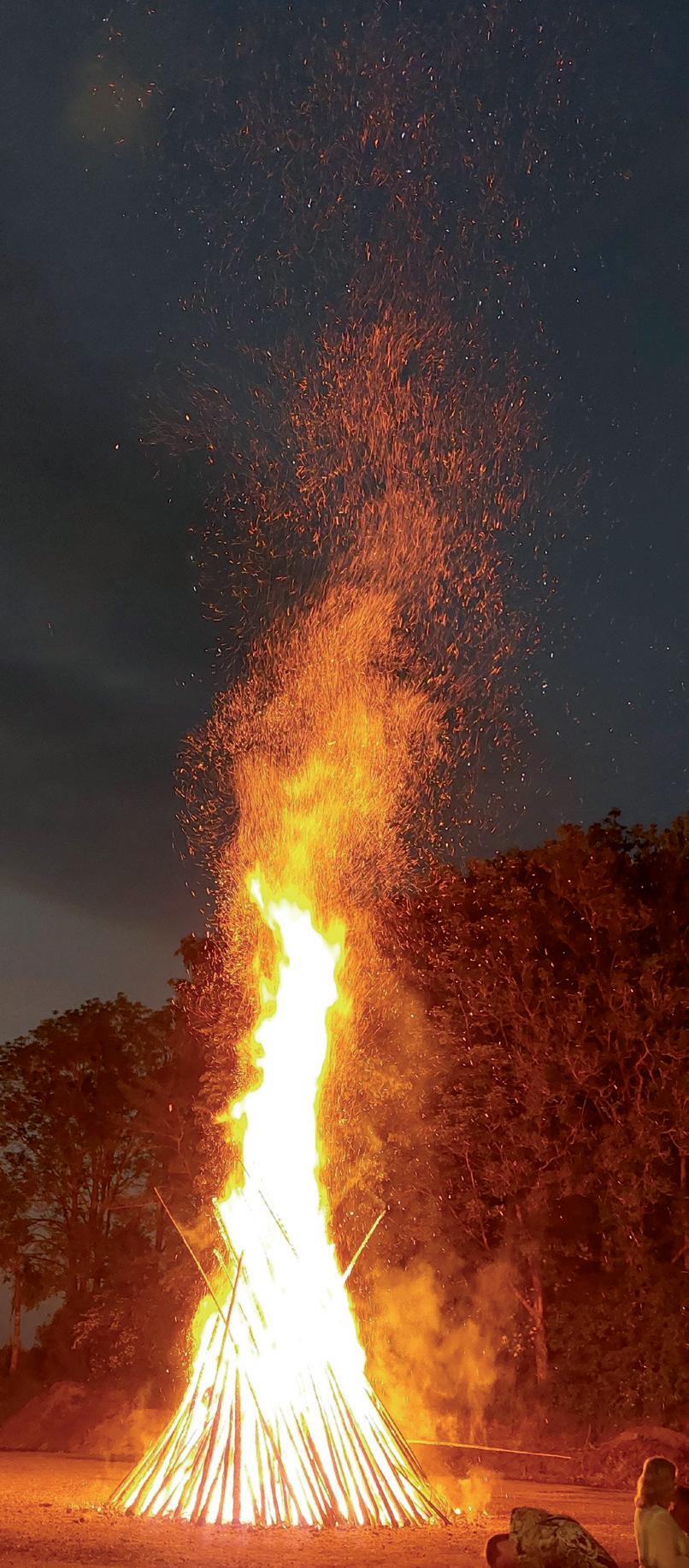
5 minute read
ABC in KMC: Summer Solstice
by Gina Hutchins-Inman, 86th Airlift Wing Public Affairs
Johannisnacht, also known as St. John’s Eve, is a festive celebration associated with summer solstice and has had key significance throughout history. This is the time of the year at which the sun reaches its maximum declination marked by the longest day of the year. Sunrise will be at 5:23 a.m. in Kaiserslautern tomorrow, providing a sunlight duration of more than 16 hours. In other words, summer is here!

The Roman calendar marked June 24 as the summer solstice and was celebrated during the Vestalia festival. It honored Vesta, the goddess of the hearth. Rituals included married women entering the temple of Vesta to leave offerings in exchange for blessings for their families.
In Ireland, St. John’s Eve, also known as Midsummer, has deep Celtic roots. On this magical night, great bonfires are lit, and fairs and festivals are held. The sacred Celtic fire was ceremoniously kindled, and people watched for the first flash from Howth’s western promontory (near today’s Dublin). As the signal spread, local fires blazed, encircling Ireland in a ring of flame. The Goddess Áine was also honored during this time, as she ruled as a fairy queen and banshee, associated with prosperity and abundance. People carried burning hay or straw torches to ensure fertility for the year ahead.

Stonehenge in England was meticulously designed to align with the sun’s movement. During the summer solstice, the sun rises just to the left of the outlying Heel Stone in the north-east part of the horizon. Standing in the middle of the monument on a midsummer’s day, the sun’s first rays shine directly into the heart of Stonehenge, where visitors can witness the sensational occurrence.
Sankthansaften owes a debt to Viking and pagan traditions. It celebrates the summer solstice and the return of light. The Vikings revered the summer solstice as the peak of summer, marked by long days and flourishing crops. They held large feasts and made offerings to honor the gods and seek prosperity.
The tradition lives on in Scandinavia, where people celebrate Sankthansaften and Midsummer is celebrated with gusto. Sweden, in particular, has vibrant fests, where people dance around a pole called Midommarstang decorated with greenery, gather for festive meals with friends and bonfires, and women and girls adorn their heads with colorful summer flowers. Overall, the season is a time to revel in the warmth of summer, connect with nature, and celebrate community and tradition.
In Denmark, St. John’s Eve is called Mittsommernacht or Sankt-Hans-Nacht. People light fires to honor the sun and nature. Dancing, singing, and flower and herb gathering are essential traditions. Dishes, such as Smørrebrød (open-faced sandwiches) and Frikadeller (Danish meatballs) are enjoyed, along with aquavit or beer. Families gather in summer houses to celebrate together. Midsummer festivals are also popular in the Baltic countries of Estonia, Latvia, Lithuania and Finland with their long, white nights.

Johannisnacht celebrations are more common in Germany’s northern states, and some festivities take place in communities close to Denmark. Smaller towns celebrate festivals with bonfires and gatherings.
The Viking city of Haithabu was a major trading hub, located near Schleswig in the state of Schleswig-Holstein, and now houses an indoor and outdoor Viking Museum. The area has ancient megalithic graves and significant archaeological finds, also linked with solstices. Special workshops will be taking place on the weekend, such as archery training, making coins and craftsmen demonstrating ancient handcraft skills.
Some Native American tribes also celebrated customs linked to the summer solstice. For example, the Sioux Sundance where young warriors engaged in singing, dancing, drumming, deep prayer, meditation, and skin piercing. Medicine wheels were stone wheels constructed with 28 spokes as a tribute to the summer solstice and aligned with sunrise and sunset during the season. A further example is Fajada Butte (Chaco Canyon, New Mexico), which is home to a solar marking site that records solstices and equinoxes (around March 20 and Sept. 23).

In our region, Rheinland-Pfalz’s capital Mainz, which has a vibrant Roman history, initiated a Johannisnacht Festival to celebrate the longest day of the year similar to the Romans. It also commemorates Johannes Gutenberg, the inventor of movable type printing. The festival takes place annually and is held from June 20 to 23 this year with events along the Rhein River and city center.
Other, not quite so traditional, events are also taking place in the area, such as the Medieval Market at Lichtenberg Castle from June 21 – 22, where the premises will turn into one colorful Medieval Market. The legendary lawn tractor races, the “Grand Prix of Sembach” also takes place from Friday to Sunday this weekend.
Sunset Times June 21, 2025
Kaiserslautern, Germany: Sunset at 9:39 p.m. local time.
North Cape, Norway: Experiences the midnight sun, with the sun setting and rising again within minutes.
Anchorage, Alaska: Sunset at 11:42 p.m., sunrise at 4:21 a.m. local time..
Arctic Circle: Continuous daylight during this period, while the Antarctic Circle experiences complete darkness for about 11 weeks.
Whether you engage in cultural events, dive into the Middle Ages, choose to party at a festival, spend an evening barbecuing with friends or just chilling on your balcony, enjoy the longest days of the year and embrace the summer with more exciting events coming soon!


